Sidhak Verma
Myself Sidhak I am a student and a content writer. I share my ideas on social media and finding ways of earning money online on the internet.
It might be challenging for anyone to choose their selections because the network monitoring industry is diversified and offers many possibilities. The...
It might be challenging for anyone to choose their selections because the network monitoring industry is diversified and offers many possibilities. The finest network monitoring tools for Linux are required to manage and monitor your devices. This article examines various network monitoring tools for Linux to aid in keeping tabs on the functioning of your network.
The technique of controlling and analyzing network traffic on a Linux-based system is known as Linux network monitoring. This entails monitoring a network’s numerous servers, routers, switches, and other devices to ensure everything is running well and looking for any possible problems.
Linux users may monitor network traffic, find vulnerabilities, and locate network bottlenecks using network monitoring tools. You may also use these tools to monitor the efficiency of other network elements, such as CPU, memory, and disc space consumption.

Nmap, Wireshark, Nagios, Cacti, Zabbix, and many more tools are available to monitor Linux networks. Network administrators may improve their network’s performance and decrease downtime by using these tools, which give them insightful information about their network.
In conclusion, any firm that relies on a network infrastructure based on Linux must perform the crucial duty of Linux network monitoring. It helps to ensure the network is functioning properly, spot any problems, and provide the essential data to troubleshoot and improve the network’s performance.
The top network monitoring solutions offer extensive network, server, and application monitoring, alerting, and reporting features. Moreover, they must be versatile and expandable to support the Monitoring of a variety of network elements. One of the most important characteristics of a top-notch network Monitoring tool is its ability to:
N-able N-central is a software platform for remote Monitoring and management (RMM) used by IT service providers and Managed Service Providers (MSPs). With a single, centralized dashboard, they can monitor and manage their clients’ IT networks, servers, and equipment. It offers a variety of tools for controlling networks, servers, and other devices, including
N-central automates time-consuming, repetitive procedures so MSPs can work more effectively and enhance their service offerings.
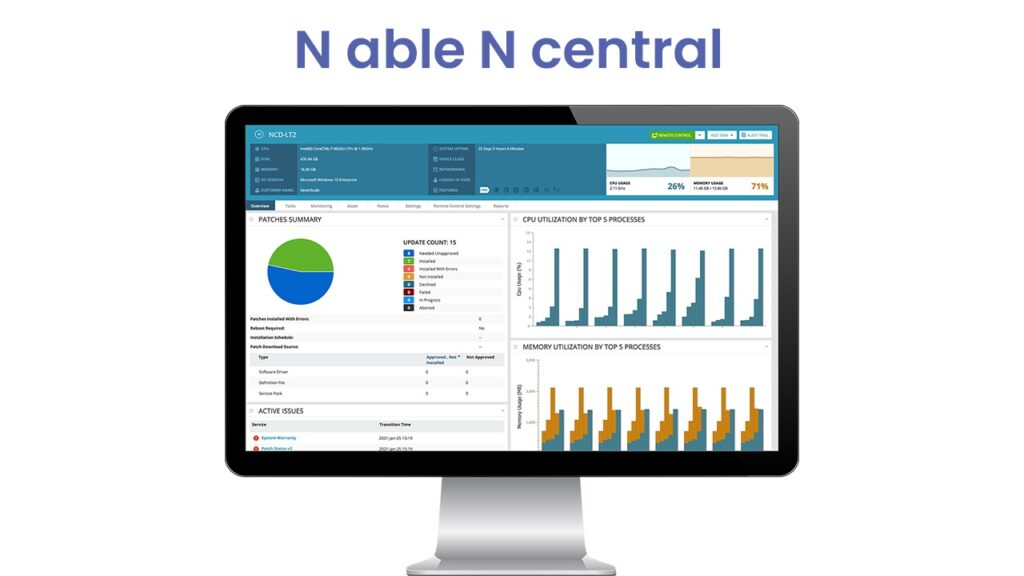
A platform for managing and monitoring IT infrastructure in the cloud is called Site24x7. Networks, servers, apps, and cloud resources are monitored in real-time, and alerts are sent. Various capabilities are available through Site24x7 for controlling and monitoring IT infrastructure.
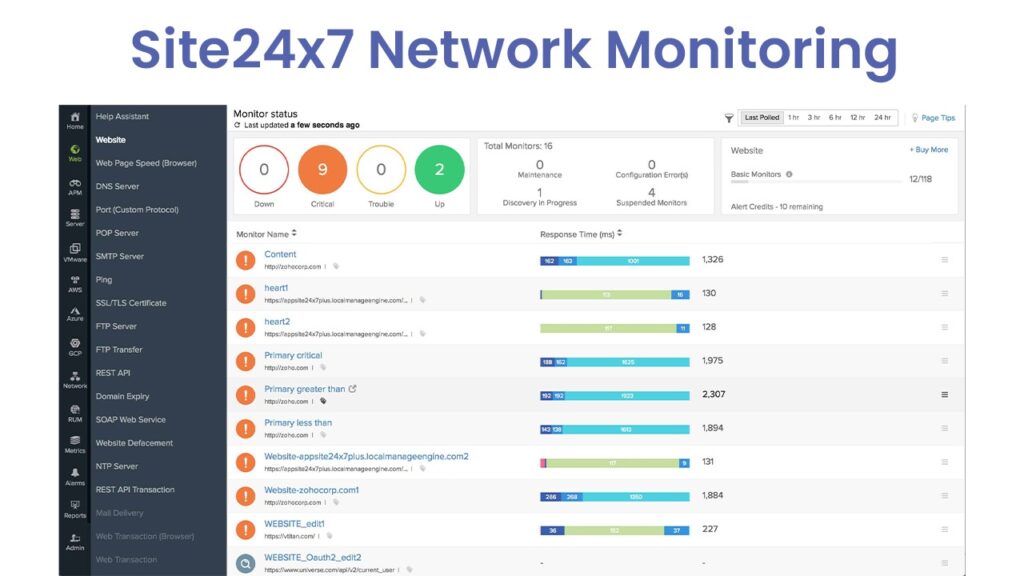
The “Free Plan” is the entry-level price option, which offers basic monitoring functions and alerts for up to 5 servers, 30 websites, and 30 cloud resources.
The “Standard Plan” is the next level, which covers monitoring up to 25 servers, 100 websites, and 100 cloud resources with root cause analysis, alerts, and advanced monitoring tools.
The “Pro Plan,” with all features, sophisticated alerts, root cause analysis, and round-the-clock assistance, is the most expensive price option. It covers monitoring up to 100 servers, 300 websites, and 300 cloud resources.
The Basic and Pro plans cost monthly or annually depending on the number of resources that you must track. For business clients with more than 100 servers, 300 websites, and 300 cloud resources, Site24x7 also provides a tailored package.
It’s important to note that Site24x7 provides a free platform trial that enables consumers to evaluate all features before choosing a subscription.
Paessler AG created PRTG Network Monitor, a for-profit network Monitoring software program. It is intended for network, server, and application performance analysis and Monitoring.
For controlling and monitoring IT infrastructure, PRTG provides a wide range of features, including
PRTG is available in a free version with a small number of sensors and a premium version with more sensors and more sophisticated functions.
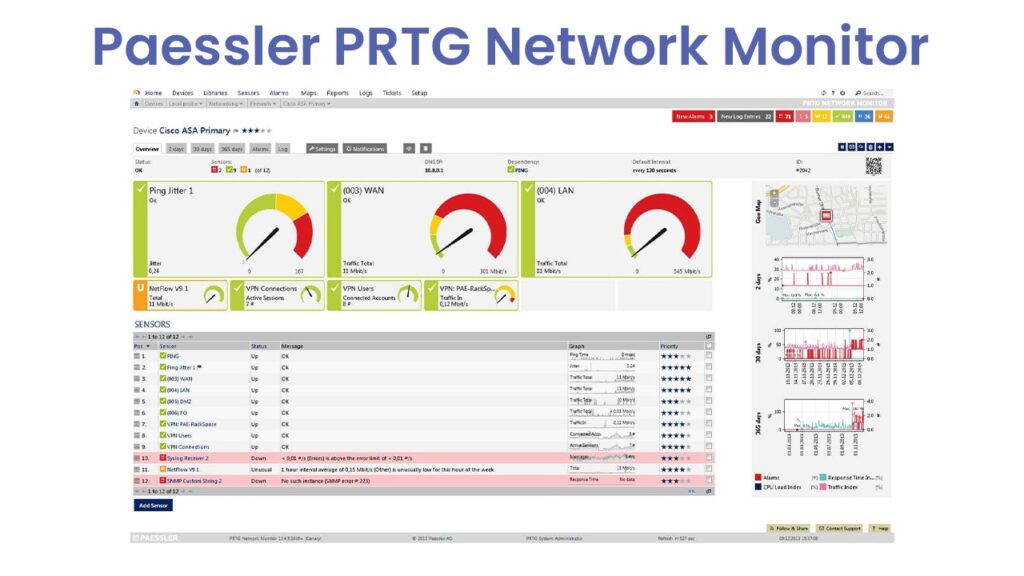
Based on the number of sensors utilized for Monitoring, PRTG Network Monitor offers a variety of price levels. An individual feature of a device or service, such as CPU, memory, or disc utilization, is monitored by PRTG as a sensor. The size and complexity of the network will determine how many sensors are required to watch it.
A free version of PRTG Network Monitor called “PRTG Free” offers up to 100 sensors and fundamental monitoring functionality. Small networks or software testing can both benefit from using this version.
You may include up to 1,000 sensors in the “PRTG 1000,” including all capabilities, enhanced reporting, access to an alerting mobile app, and priority email assistance.
A limitless number of sensors, all features, comprehensive reporting, alerting, mobile app access, first-class email assistance, and a dedicated support contact are all included in the “PRTG Unlimited.”
The number of sensors determines how much the PRTG Network Monitor costs. If your company needs more than 2,500 sensors, you may also ask for a price for a unique package.
OpManager is a program created by ManageEngine for network, server, and application monitoring. Automating several repetitive and time-consuming operations related to Monitoring and maintaining IT infrastructure is intended to assist IT, teams, IT service providers, and Managed Service Providers (MSPs) in increasing efficiency and improving their service offerings.
One of OpManager’s key features is its real-time monitoring functionality, which enables users to monitor network devices, servers, and applications to discover and address problems swiftly. This makes it possible to maintain optimal levels of network performance and availability. The time and effort needed to keep software updated can be decreased by OpManager’s automated software updates and patches.
To keep track of the hardware and software on their network and to produce reports on the state and performance of their network, OpManager delivers inventory management and reporting. Moreover, OpManager offers automation and scripting features that help reduce the time and effort needed to complete routine activities.
OpManager also provides troubleshooting and root cause investigation. This function can aid in spotting possible issues before they become serious. To thoroughly monitor network devices, servers, and applications, OpManager supports various monitoring protocols, such as SNMP, WMI, packet sniffing, and others.
Moreover, OpManager provides adaptable licensing choices that let IT teams select the number of devices they need to watch over and scale up as their network expands. This can save expenses and guarantee that the software is always suitable for the company’s demands.
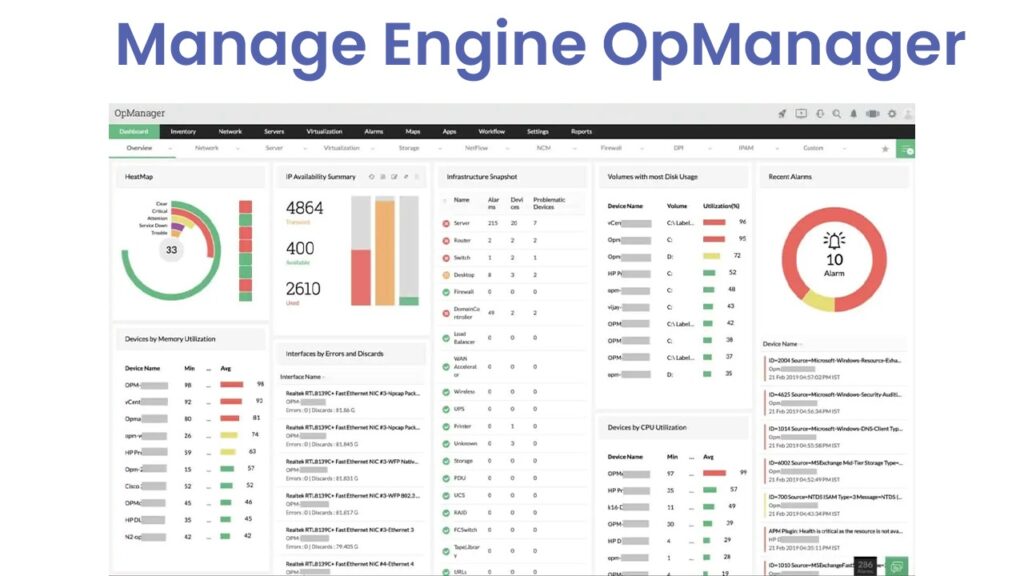
It offers a variety of price plans based on the number of devices that need to be monitored. The pricing plans change according to the necessary features, support choices, and device count. OpManager offers a free trial edition that enables you to monitor up to 100 devices and provides fundamental monitoring functions.
The “Standard” plan, which allows you to monitor up to 250 devices and includes sophisticated monitoring tools, reporting, and alerting, is the next stage.
The “Professional” subscription gives you access to the mobile app, all capabilities, comprehensive reporting and alerts, and the capacity to track up to 500 devices.
The “Enterprise” plan includes all features, including comprehensive reporting and alerting, mobile app access, and unlimited device monitoring. A configurable dashboard, connection with other ManageEngine products, and round-the-clock support are among the extra features offered by this subscription.
With an optional maintenance contract offering software updates and technical assistance, OpManager’s pricing depends on the number of devices and is paid on a perpetual license. Businesses that need to monitor more than 500 devices also offer bespoke pricing plans.
It’s important to remember that ManageEngine provides various IT management software options. OpManager may connect several of them to offer a complete IT management solution.
IT, DevOps, and software companies can use the cloud-based Monitoring and analytics software called Datadog. It offers features for log management, tracing, security analytics, and real-time Monitoring. And alerting for networks, servers, apps, and cloud resources. It provides a wide range of functions for managing and monitoring IT infrastructure. Such as real-time Monitoring and alerting for network performance, availability, and security.
Datadog is a Software as a Service (SaaS) product that does not require installing, upkeep, or upgrading any software.
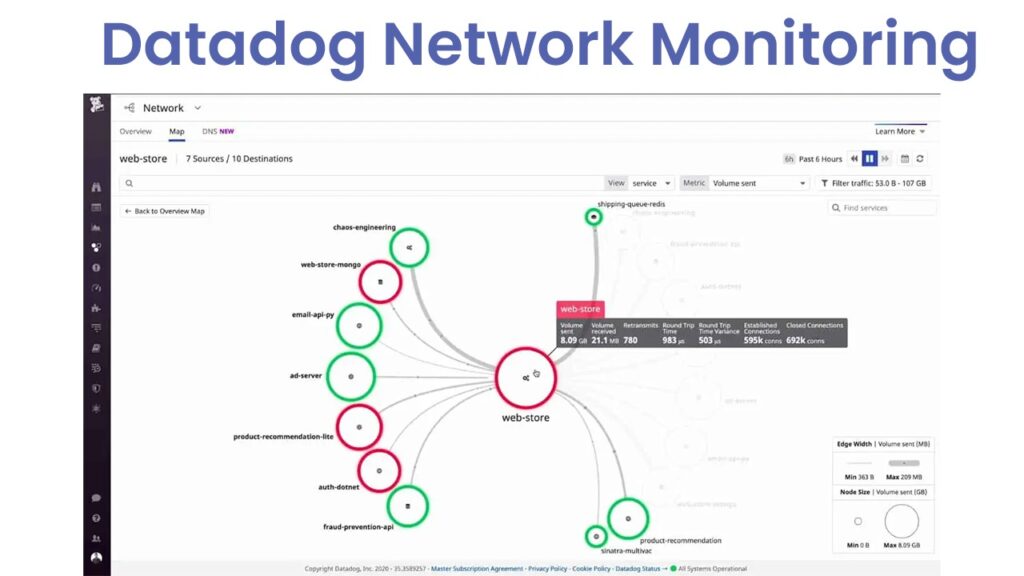
Various price tiers are available for the cloud-based Monitoring and analytics platform Datadog, depending on the number of hosts, metrics, and functionality needed. Thanks to the company’s free trial offer, users may test the platform for 14 days without paying for a plan.
The three types of Datadog pricing plans are Essential, Pro, and Enterprise. The most basic subscription, Basic, comes with Monitoring for up to 5 hosts. You may monitor up to 100 hosts with the Pro subscription, which offers extra capabilities like log management and anomaly detection. The Enterprise package includes unlimited host monitoring, on-premises data collecting, and a dedicated customer success manager.
Each plan’s cost is determined by the number of hosts and metrics and is charged on a subscription basis; this basis is commonly monthly or yearly. The firm also provides bespoke pricing options for businesses that need more than 100 hosts or have other requirements that need to be covered by the regular plans.
It’s important to note that Datadog’s prices change based on your location, so it’s advised to verify them on their official website or contact them for more details.
An open-source network monitoring program called Nagios offers real-time Monitoring and alerts for network availability, security, and performance. It may assist IT professionals in promptly identifying and resolving issues because it is made to monitor the performance and availability of network devices, servers, and applications.
Nagios’s high adaptability enables IT teams to monitor certain servers, network devices, and applications while setting unique thresholds and alarms. Nagios’ plugin architecture, which allows users to add additional monitoring capabilities to the program quickly, is one of its key features. Nagios supports Monitoring protocols, such as SNMP, NRPE, and others, and enables users to monitor Windows and Linux systems.
Moreover, Nagios provides a web-based interface that enables users to examine the condition of their network and get notifications when problems occur. The user-friendly interface offers comprehensive network availability and performance data, allowing them to delve further into certain issues.
As Nagios is open-source software, it may be customized to meet particular requirements and is free to use. But, setting up, configuring, and troubleshooting problems when they occur require technical competence. Nagios is a dependable choice for IT teams and MSPs because of its extensive community of users and developers who contribute to the program and offer assistance.
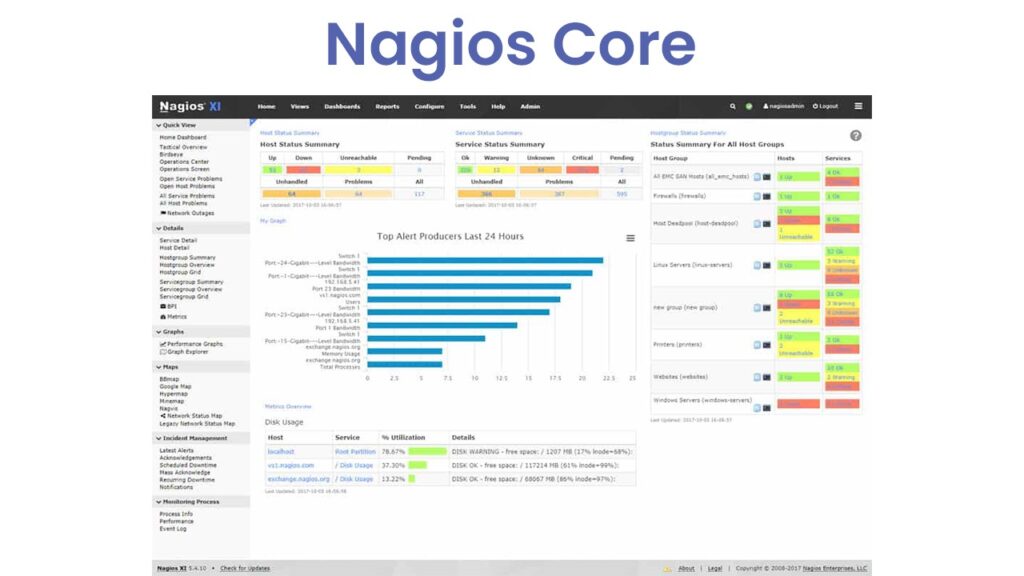
The network monitoring program Nagios is free and open-source. The GNU General Public License allows anybody to download, use, and change it for free and grants them the right to alter and distribute it. On the other hand, Nagios Core, the open-source variant of Nagios, is a monitoring system that needs technical know-how to set up and configure.
The organization that created Nagios also sells commercial versions of Nagios XI and Nagios Log Server, which provide more capabilities and a web-based interface, in addition to Nagios Core. Some variations cost money and have a commercial license. Compared to Nagios Log Server, which has a starting price of $1,995 for a perpetual license and $1,995 for an annual subscription, Nagios XI has a lower starting price of $995 for a yearly subscription.
It is simpler for IT companies and MSPs to manage and monitor their IT infrastructure because of the extra capabilities offered by these commercial Nagios versions, such as a web-based interface, sophisticated reporting and visualization, and a more user-friendly interface. To assist clients in getting the most out of their Nagios investment, Nagios Enterprises also offers training, support, and consulting services.
One open-source monitoring program is Zabbix. It is intended to keep track of the functionality and availability of servers, network devices, and software. Zabbix offers a variety of capabilities for Monitoring and controlling IT infrastructure, such as support for SNMP, JMX, IPMI, and other monitoring protocols. It also enables real-time Monitoring and alerting for network performance, availability, and security.
Although Zabbix is free and open-source and has to be installed on a Linux-based computer, setting it up and configuring it takes some technical know-how.
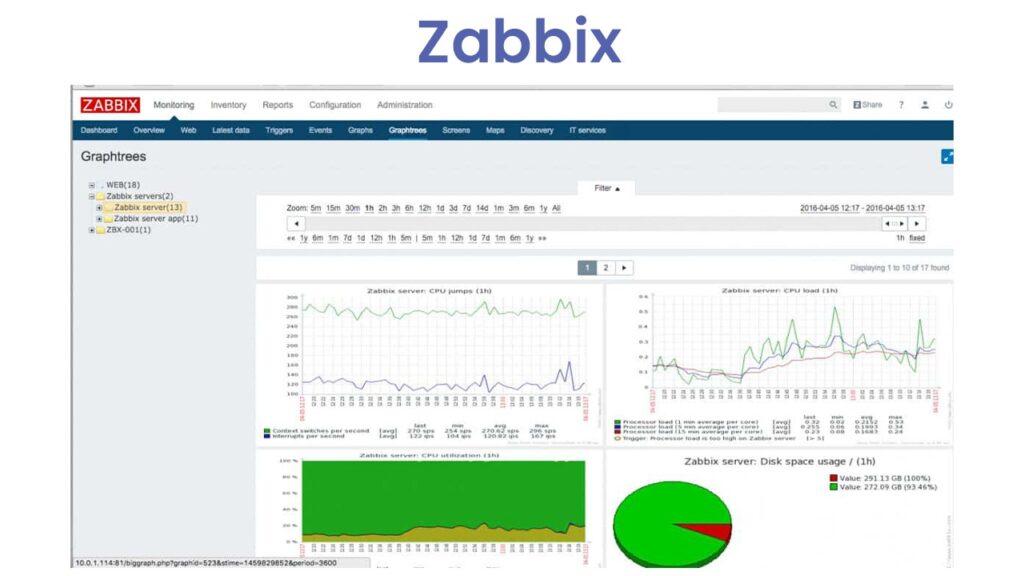
Icinga is free software for network monitoring. It monitors the functionality and performance of servers, network devices, and software. Icinga offers a variety of capabilities for Monitoring and controlling IT infrastructure, including support for SNMP, NRPE, and other monitoring protocols. It also supports real-time Monitoring and alerting for network performance, availability, and security.
Icinga is free and open-source software that you must install on a Linux-based computer, but it takes some technical know-how to set up and configure.
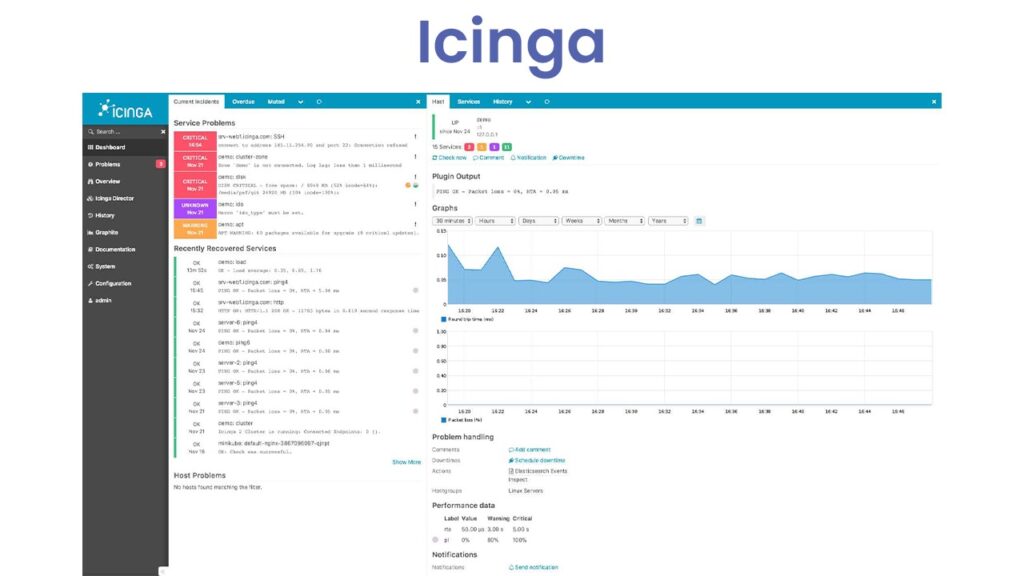
Linux needs network monitoring tools to ensure the functionality and availability of servers, clients, and network devices. These tools aid in the early identification and resolution of problems and the maintenance of optimal network performance and availability. The following are some of the main justifications for why Linux network monitoring tools are necessary:
In general, Linux network monitoring tools are crucial for preserving the availability and performance of network devices, servers, and applications, as well as for guaranteeing the public safety and security of the network.
Tools for network monitoring are becoming crucial. And foremost is the top Linux network monitoring tools. All instruments are top-notch. However, they vary depending on your requirements or individual demands. Share this post with your friends and family if you enjoyed reading it. Moreover, if you have any recommendations for network monitoring tools, please share them with us. We will utilize them to better our posts.
Suggested:
List of Top Network Marketing Books.
Best Linux Distribution for kids.
Thanks for sharing such useful information.